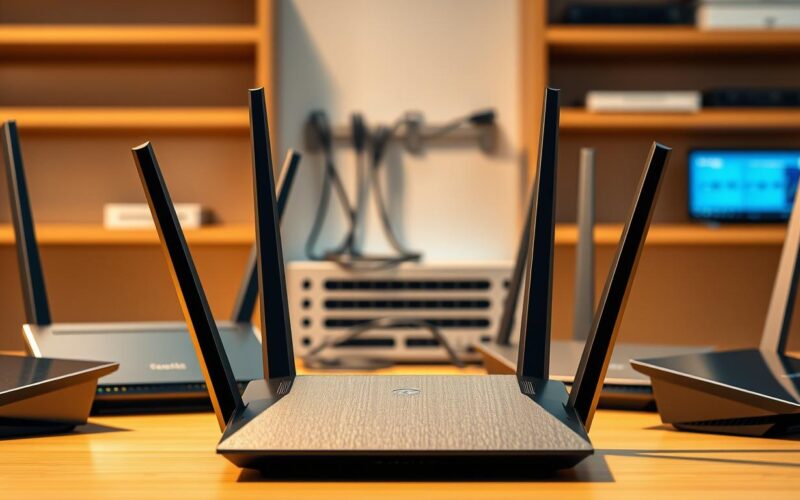Did you know that by 2025, the average home will rely on internet speeds exceeding 1 Gbps? This demand is driven by smart devices, streaming, and remote work. A reliable router is no longer optional—it’s essential for seamless connectivity.
Router technology has evolved significantly, with Wi-Fi 7 leading the charge. These devices now support multiple bands, including 2.4GHz, 5GHz, and 6GHz, ensuring faster speeds and better coverage. Whether you’re upgrading your home setup or optimizing a business network, choosing the right router is crucial.
This guide covers a range of options, from high-end models like the Asus RT-BE96U, which delivers over 3 Gbps, to budget-friendly picks like the TP-Link Archer AX21, offering speeds up to 1,201 Mbps12. We’ve also included insights from recent tests, ensuring you make an informed decision.
Key Takeaways
- Routers are critical for modern homes and businesses, supporting high-speed internet needs.
- Wi-Fi 7 routers offer advanced features like multi-Gigabit ports and compatibility with the latest devices.
- Speed, reliability, and security are key factors when choosing a router.
- High-end models like the Asus RT-BE96U deliver exceptional performance for demanding users.
- Budget-friendly options like the TP-Link Archer AX21 provide excellent value without compromising quality.
Overview of Wireless Router Trends for 2025
Emerging trends in routers are reshaping how we experience the internet. With the rise of Wi-Fi 6E and Wi-Fi 7 technologies, speed and range have become critical factors. These advancements ensure faster data transfer and broader coverage, meeting the demands of modern homes and businesses3.
Recent tests highlight the importance of multi-band performance. Devices like the Asus ROG Rapture GT-BE98, with quad-band capabilities, deliver unparalleled speeds up to 24.4Gbps3. This ensures a stable connection even in high-traffic environments.

The shift to Wi-Fi 7 is a game-changer. Routers like the TP-Link Archer BE230, priced at $99.99, offer dual-band Wi-Fi 7 support, making advanced technology accessible4. These devices are designed to handle the increasing number of smart devices in homes.
Reliability is another key focus. Throughput tests show that models like the Asus ZenWiFi AX (XT8) maintain speeds of up to 570Mbps on a 500Mbps connection3. This ensures consistent performance for streaming, gaming, and remote work.
“The future of networking lies in routers that can handle both speed and stability seamlessly.”
Multi-band routers are also adapting to rising internet demands. Devices like the Google Nest Wifi Pro, with tri-band support, provide coverage for larger homes3. This ensures every corner of your space stays connected.
As technology evolves, so do consumer expectations. Routers are no longer just about connectivity—they’re about delivering a seamless, high-performance experience. With advancements in speed, range, and multi-band capabilities, the future of networking looks brighter than ever.
Understanding Wi‑Fi Standards and Innovations
Wi-Fi standards have evolved rapidly, shaping how we connect and interact online. From Wi-Fi 6 to the upcoming Wi-Fi 7, these advancements are designed to meet the growing demands of modern networks. Let’s dive into the technical aspects of these standards and the innovations driving superior performance.
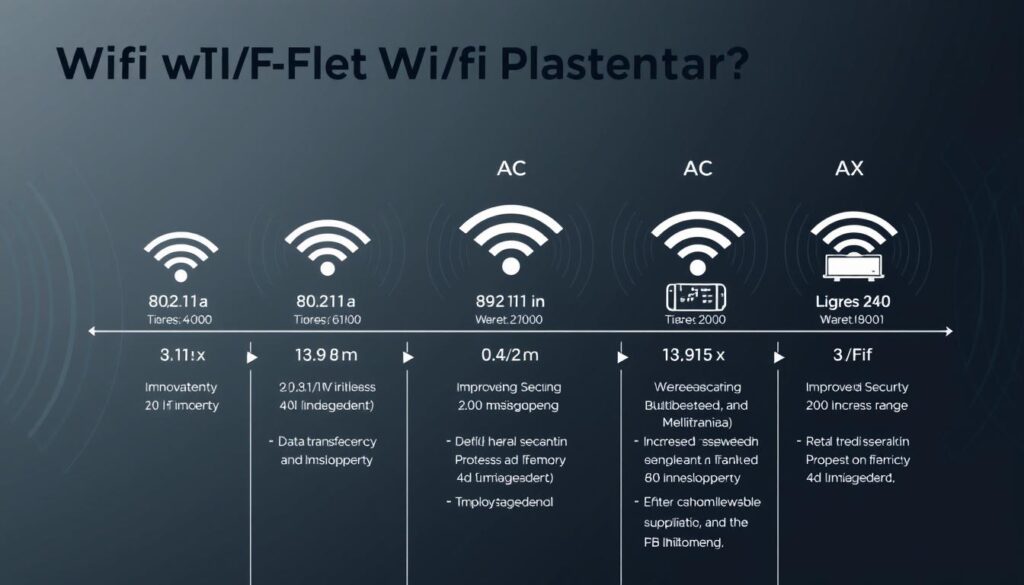
Wi-Fi 6, 6E, and 7 Explained
Wi-Fi 6 introduced significant improvements in speed and efficiency, supporting higher data rates and better performance in crowded areas. It operates on both the 2.4 GHz and 5 GHz bands, making it versatile for various devices5.
Wi-Fi 6E extends these capabilities by adding the 6 GHz band, reducing congestion and enabling faster speeds. This is particularly beneficial for high-bandwidth activities like streaming and gaming6.
Wi-Fi 7, the next frontier, promises even greater advancements. With wider channels and higher frequencies, it aims to deliver multi-Gigabit speeds and ultra-low latency. This makes it ideal for future-proofing your network5.
Emerging Technologies and Network Capabilities
The 2.4 GHz band remains essential for long-range connections, while higher GHz bands like 5 GHz and 6 GHz offer faster speeds and reduced interference. Devices like the TP-Link Archer AX3000 Pro leverage these bands to achieve speeds up to 887 Mbps5.
New features such as MU-MIMO and OFDMA improve throughput and lower latency, ensuring smoother performance for multiple devices. These innovations are critical for homes with smart devices and high-traffic networks6.
Device compatibility is another key consideration. While Wi-Fi 6 and 6E are widely supported, Wi-Fi 7 requires newer hardware. Clients should ensure their devices are compatible to fully benefit from these advancements5.
“The future of networking lies in standards that balance speed, reliability, and compatibility.”
Real-world testing highlights the impact of these standards. For example, the TP-Link Archer AX3000 Pro maintains stable performance even in busy networks, handling traffic 99% of the time5. Such results underscore the importance of choosing the right Wi-Fi standard for your needs.
As networks continue to evolve, understanding these standards will help you make informed decisions. Whether you’re upgrading your home setup or optimizing a business network, staying ahead of the curve is essential.
Key Features to Look for in Wireless Routers
Modern homes demand advanced connectivity solutions, making router features more critical than ever. Whether you’re streaming, gaming, or working remotely, the right hardware ensures seamless performance.
One of the first features to consider is multi-band support. Dual-band routers operate on both 2.4 GHz and 5 GHz frequencies, offering a balance between range and speed. For larger homes or high-traffic networks, tri-band routers add an extra 5 GHz band, reducing congestion and improving performance7.
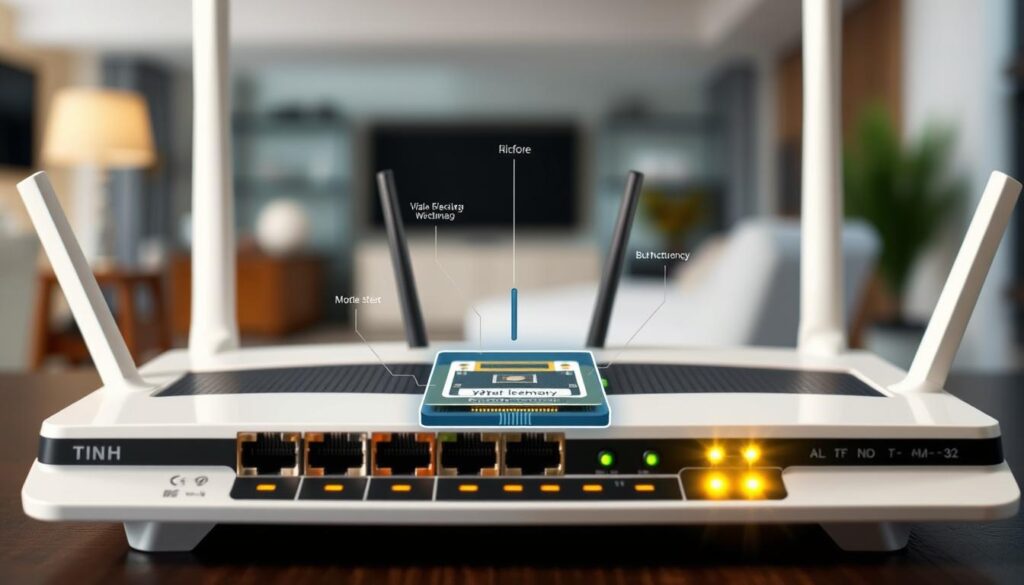
Port configurations are equally important. Multiple LAN ports allow you to connect wired devices like gaming consoles or smart TVs. A WAN port is essential for linking your router to the modem, ensuring a stable internet connection8.
High-speed Ethernet ports are another must-have. Models like the TP-Link Archer BE550 feature ports rated for 2.5Gbps, enabling fast data transfer for multiple devices8. This is particularly useful for homes with heavy internet usage.
When comparing models, high-end options like the ASUS RT-BE96U deliver exceptional speeds, while budget-friendly picks like the TP-Link Archer AX20 offer solid performance at a lower cost8. Here’s a quick comparison:
| Feature | High-End (ASUS RT-BE96U) | Budget (TP-Link Archer AX20) |
|---|---|---|
| Bands | Tri-band | Dual-band |
| LAN Ports | 4 (2.5Gbps) | 4 (1Gbps) |
| WAN Port | Yes | Yes |
| Ethernet Ports | High-speed | Standard |
Choosing the right router depends on your specific needs. For larger homes, a tri-band model with multiple LAN ports is ideal. Smaller setups can benefit from a dual-band router with essential features like a WAN port and high-speed Ethernet ports.
“The right combination of features ensures your network can handle today’s demands and future advancements.”
By focusing on these key features, you can select a router that meets your connectivity needs and enhances your internet experience.
How to Choose the best wireless routers for Your Home
Choosing the right router for your home can significantly enhance your internet experience. With so many options available, it’s essential to consider factors like coverage area, device density, and performance metrics to make an informed decision.
Start by evaluating your home’s size and layout. For larger spaces, models like the TP-Link Archer AXE75 offer tri-band support, ensuring consistent coverage even in high-traffic areas9. Smaller homes can benefit from dual-band routers, which balance speed and range effectively.

Device density is another critical factor. If your home has multiple smart devices, a router with MU-MIMO technology ensures efficient handling of simultaneous connections9. The TP-Link Archer AX3000 Pro, for example, maintains a responsive network 99% of the time, making it a reliable pick5.
Essential features like parental control and robust security are also worth considering. Advanced parental-control software allows you to manage internet access for specific devices, while WPA3 encryption provides stronger protection against hacking attempts10.
Performance metrics like speed and latency directly impact your internet connection. For households with 4K streaming or gaming needs, a router with a 2.5 Gigabit Ethernet port, like the TP-Link Archer AX3000 Pro, ensures future-proofing and faster data transfer5.
Balancing cost and performance is key. While high-end models offer advanced features, budget-friendly options like the TP-Link Archer AX20 provide excellent value without compromising quality5. Here’s a quick comparison to help you decide:
| Feature | High-End (TP-Link Archer AXE75) | Budget (TP-Link Archer AX20) |
|---|---|---|
| Bands | Tri-band | Dual-band |
| Parental Control | Advanced | Basic |
| Ethernet Ports | 2.5 Gigabit | 1 Gigabit |
| Security | WPA3 | WPA2 |
Prioritize features that align with your home networking needs. Whether it’s extensive coverage, advanced security, or cost-effectiveness, the right router ensures a seamless and reliable internet experience.
“The right combination of features ensures your network can handle today’s demands and future advancements.”
In‑Depth Reviews of Top‑Rated Models
In today’s connected world, selecting the right router can make or break your online experience. Whether you’re looking for cutting-edge features or budget-friendly options, this section dives into detailed reviews of top-rated models to help you make an informed decision.
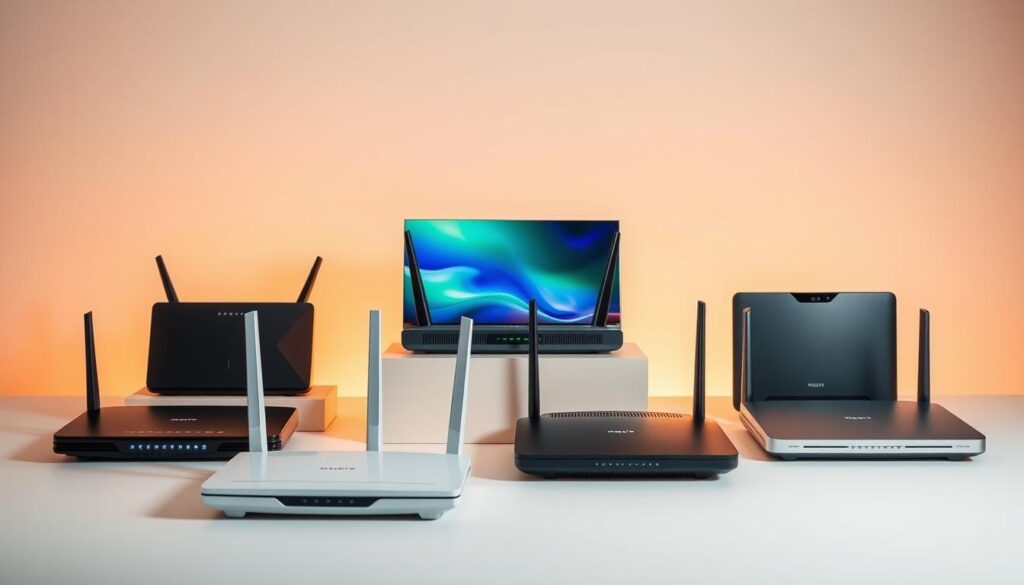
High-End Options and Their Cutting-Edge Features
High-end models like the Asus RT-BE96U and Netgear Nighthawk RAXE300 are designed for users who demand the best performance. The Asus RT-BE96U boasts a peak throughput of 1.948 Gbps at 15 feet and a range of over 100 feet, making it ideal for large homes11.
This model also features multi-gig ports, including a 10 Gbps WAN port, ensuring lightning-fast data transfer11. For those who prioritize range, the Netgear Nighthawk RAXE300 offers a 5 GHz range of 170 feet before buffering, making it a top pick for expansive spaces12.
- Asus RT-BE96U: 10 Gbps WAN port, 8 antennas, and touchscreen controls.
- Netgear Nighthawk RAXE300: Quad-band support, 9.5 range score, and advanced security features.
Budget-Friendly Alternatives and Value Picks
For those on a budget, the TP-Link Archer AX55 and Reyee RG-E6 offer excellent value without compromising performance. The TP-Link Archer AX55 delivers a peak throughput of 823.7 Mbps at 15 feet and maintains solid speeds up to 120 feet11.
This model is a top pick for smaller homes, offering four gigabit LAN ports and a USB 3.0 port for added versatility11. The Reyee RG-E6, priced under $150, is another great option, with a peak throughput of 1.148 Gbps and eight non-removable antennas11.
- TP-Link Archer AX55: Dual-band support, parental controls, and WPA3 encryption.
- Reyee RG-E6: 2.5 Gbps WAN port, eight antennas, and budget-friendly pricing.
“Choosing the right router depends on your specific needs. High-end models offer advanced features, while budget options provide reliable performance at a lower cost.”
When comparing high-end and budget models, consider your home’s size, device density, and performance requirements. High-end routers like the Asus RT-BE96U are ideal for demanding users, while budget-friendly options like the TP-Link Archer AX55 offer excellent value for smaller setups11.
| Feature | High-End (Asus RT-BE96U) | Budget (TP-Link Archer AX55) |
|---|---|---|
| Throughput | 1.948 Gbps | 823.7 Mbps |
| Range | 100+ feet | 120 feet |
| Ports | 10 Gbps WAN, 3 gigabit LAN | 4 gigabit LAN |
| Price | $699 | $100 |
Whether you opt for a high-end or budget model, ensure it meets your connectivity needs. With the right router, you can enjoy seamless streaming, gaming, and remote work experiences.
Performance Considerations: Speed, Range, and Throughput
Understanding the real-world performance of your network device is essential for seamless connectivity. Speed, range, and throughput are the key benchmarks that define how well your device handles daily tasks like streaming, gaming, and file transfers13.
Real-world testing methods are crucial for evaluating performance. Experts measure throughput by simulating high-traffic scenarios, ensuring the device can handle multiple connections simultaneously14. For example, the Asus RT-BE86U delivers consistent speeds on the 5-GHz band, making it a reliable choice for demanding applications14.
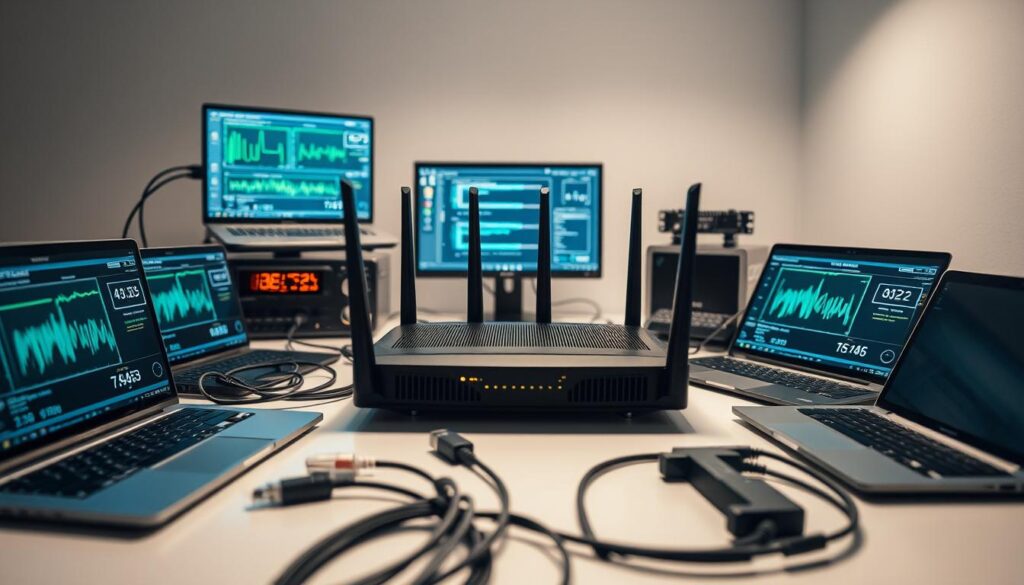
Speed is a critical factor for activities like 4K streaming, which requires at least 25 Mbps per stream13. Devices like the TP-Link Archer BE800 excel in this area, offering top performance across 2.4-GHz, 5-GHz, and 6-GHz bands14. This ensures smooth streaming even in households with multiple devices.
Range is equally important, especially for larger homes. The Netgear Nighthawk M6 Pro covers approximately 1,000 square feet, making it ideal for expansive spaces14. However, real-world conditions like walls and interference can reduce this range, so lab results may differ from actual performance.
Throughput testing highlights how well a device manages data transfer. The Linksys Hydra Pro 6E maintains reliable performance at close range, but its speed drops with distance14. This underscores the importance of choosing a device that matches your home’s layout.
“A stable connection is vital for demanding applications like gaming and remote work. Real-world testing ensures your device can handle these tasks seamlessly.”
Comparative data reveals the strengths and weaknesses of different models. For instance, the TP-Link Archer AXE75 shows fast speeds on the 6-GHz band at close range but struggles with distance14. Here’s a quick comparison of top models:
| Model | Speed (Mbps) | Range (ft) | Throughput |
|---|---|---|---|
| Asus RT-BE86U | 1,948 | 100+ | High |
| TP-Link Archer BE800 | 2,400 | 120 | Excellent |
| Netgear Nighthawk M6 Pro | 1,000 | 1,000 sq ft | Good |
By focusing on these performance metrics, you can select a device that meets your needs. Whether it’s for streaming, gaming, or remote work, a stable connection ensures a seamless online experience.
Design Innovations and Aesthetic Appeal in Routers
The design of modern network devices has evolved to blend functionality with aesthetics, making them a seamless part of home décor. No longer just functional gadgets, these devices now complement interior styles, offering customizable options that enhance both look and performance15.
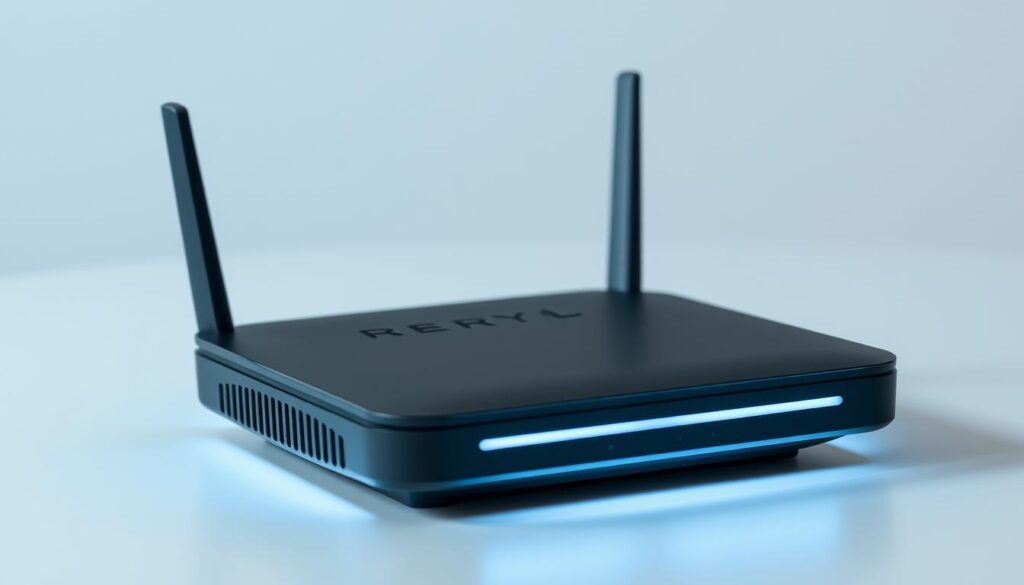
Modern Designs with Customizable Options
Innovative design elements are transforming how we perceive network devices. For instance, the Vibrant WiFi router features a switchable enclosure, allowing users to customize its appearance with different colors, materials, and finishes15. This flexibility ensures the device blends harmoniously with any interior style.
Compact form factors are another trend, reducing clutter and making placement easier. Devices like the Synology RT2600ac are designed to fit seamlessly into modern homes, offering both aesthetic appeal and reliable performance16.
Customization isn’t just about looks—it also impacts functionality. RGB lighting, for example, not only adds a decorative touch but can also indicate network status, enhancing user experience15.
Design Elements That Enhance Performance
A well-designed device can improve performance. The TP-Link AXE16000 Archer AXE300 features eight antennas for improved coverage, while its sleek design ensures efficient cooling, maintaining reliability during heavy use16.
Ease of placement is another critical factor. Devices like the Netgear Orbi AX5400 are designed to cover large areas without compromising on aesthetics, making them ideal for expansive homes16.
“A router’s design should not only look good but also enhance its functionality, ensuring it performs reliably in any setting.”
Integrated Service and Support Features
Modern devices often come with integrated service and support features via mobile apps. The Synology RT6600ax, for example, includes VPN support and a user-friendly app for easy management16.
These features not only simplify setup but also enhance the overall user experience, making it easier to manage your network from anywhere.
- Customizable enclosures allow for personalization, blending the device with home décor.
- Compact designs reduce clutter and make placement easier.
- RGB lighting adds both aesthetic and functional value.
- Integrated apps provide seamless management and support.
By focusing on design and aesthetics, manufacturers are creating devices that not only perform well but also enhance the visual appeal of your home. Whether it’s through customizable options or compact form factors, modern network devices are redefining what it means to be both functional and stylish.
Security and Parental Controls in Modern Routers
In today’s digital age, safeguarding your home network is more critical than ever. With the increasing number of connected devices, ensuring robust security and effective parental control features has become a top priority for modern households.

Built-in VPN, Cloud Services, and Safety Features
Modern routers now come equipped with advanced security features to protect your family’s online experience. Built-in VPN support ensures encrypted connections, safeguarding sensitive data from potential threats17. Additionally, cloud backup services provide an extra layer of protection for your important files18.
For families, parental control features are indispensable. These tools allow you to manage internet access, set time limits, and block inappropriate content. For example, the ASUS ROG Rapture GT-AX11000 uses AiProtect Pro to offer comprehensive control over your children’s online activities17.
Other models, like the TP-Link Archer AX20, include basic parental control options through TP-Link HomeCare, making it an affordable choice for smaller households17. These features ensure a safer online environment for younger users.
“A secure network is not just about protection—it’s about creating a safe space for every family member.”
Enhanced Controls for Network Management
Advanced routers also offer enhanced control options for managing your network. Features like Dynamic DNS and static IP address configuration ensure compatibility with third-party parental control services18. This flexibility allows you to customize your security settings to meet your family’s needs.
For instance, the Gryphon AX provides IoT device isolation, preventing unauthorized access to your smart devices17. This feature is particularly useful for homes with multiple connected gadgets.
What to Look for When Comparing Models
When choosing a router, prioritize models with strong security and parental control features. Look for built-in VPN support, cloud services, and customizable control options. Ensure the router allows manual specification of IPv4 and IPv6 DNS settings for seamless integration with parental control services18.
By focusing on these features, you can create a secure and controlled network environment for your home. Whether it’s protecting sensitive data or managing your children’s internet use, the right router makes all the difference.
Mesh Systems Versus Traditional Routers: What’s Best?
When it comes to home networking, choosing between a mesh system and a traditional router can be a game-changer. Both options have their strengths, but understanding their differences is key to making the right choice for your home.

A mesh network consists of multiple nodes that work together to provide seamless coverage across large areas. Traditional routers, on the other hand, rely on a single unit to broadcast the signal. While traditional routers like the NETGEAR Nighthawk RS700S can cover up to 3,500 sq. ft., mesh systems like the NETGEAR Orbi 970 can extend coverage to 10,000 sq. ft. with a 3-pack configuration19.
One of the biggest advantages of a mesh system is its ability to handle multiple devices. For example, the NETGEAR Orbi 970 supports up to 200 devices simultaneously, making it ideal for large households19. Traditional routers may struggle with device density, especially in homes with poor layouts or construction materials that create dead zones19.
Speed is another critical factor. While traditional routers like the NETGEAR Nighthawk RS700S offer speeds up to 19 Gbps, mesh systems like the NETGEAR Orbi 970 can deliver up to 27 Gbps19. This makes mesh systems a better choice for activities like 4K streaming and gaming, where consistent speeds are essential.
However, traditional routers have their own advantages. They are often easier to set up and require less hardware. In contrast, mesh systems typically start with at least two satellites, which can increase costs19. Additionally, some mesh systems come with subscription fees for advanced features, adding to the overall expense20.
“The choice between a mesh system and a traditional router depends on your home’s size, device density, and performance needs.”
Here’s a quick comparison to help you decide:
- Coverage: Mesh systems excel in large homes, while traditional routers are better for smaller spaces.
- Speed: Both offer high speeds, but mesh systems maintain consistency over longer distances.
- Scalability: Mesh systems are more flexible, allowing you to add nodes as needed.
- Cost: Traditional routers are generally more affordable upfront, but mesh systems may require additional hardware and subscriptions.
In summary, a mesh system is ideal for large homes with multiple devices, while a traditional router is a cost-effective solution for smaller spaces. By evaluating your home’s layout and connectivity needs, you can choose the system that best suits your lifestyle.
Gaming Routers: Features and Performance Advantages
For gamers, every millisecond counts, and the right router can make or break the experience. Dedicated gaming routers are designed to prioritize traffic, minimize latency, and deliver a seamless connection for competitive play. These devices come equipped with advanced features like Quality of Service (QoS) settings, which ensure that gaming traffic gets the bandwidth it needs21.
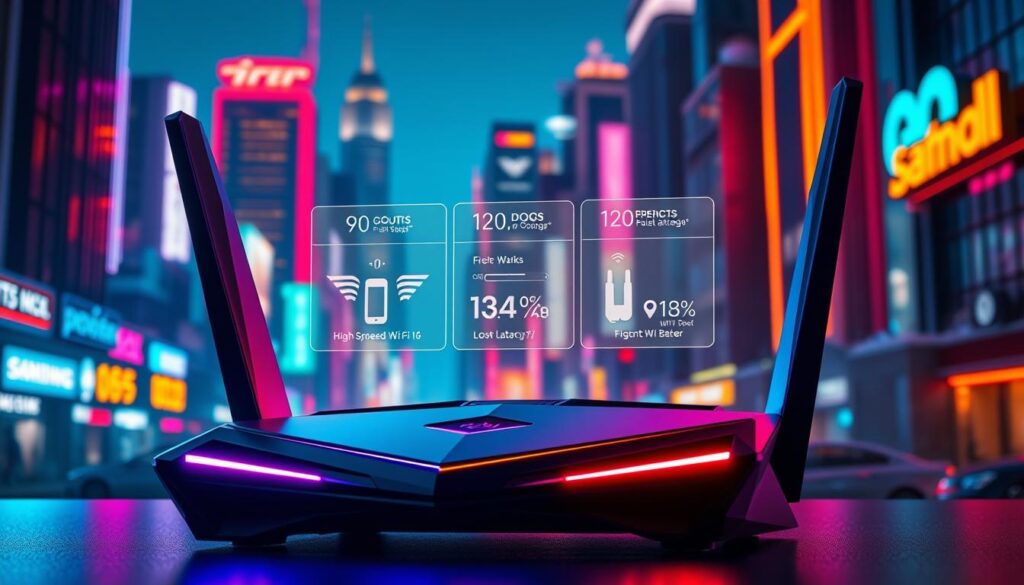
Prioritization, QoS Settings, and Optimized Connections
Gaming routers like the Asus ROG Rapture GT-AXE11000 and Netgear Nighthawk XR1000 are built to handle high-demand scenarios. They feature advanced QoS settings that allow users to prioritize gaming traffic over other activities like streaming or browsing21. This ensures that your game remains smooth, even when other devices are connected to the network.
These routers also come with optimized connections that reduce latency. For example, the Asus RT-AX86U achieved a maximum latency of just 25 milliseconds during testing, making it ideal for fast-paced games22. Lower latency means quicker response times, which can be the difference between winning and losing.
Another key feature is traffic management. Devices like the TP-Link Archer AX6000 use intelligent algorithms to manage network congestion, ensuring that gaming packets are delivered first21. This is particularly useful in households with multiple devices competing for bandwidth.
Performance Comparisons and Recommendations
When comparing gaming routers, performance metrics like speed and range are critical. The Netgear Nighthawk XR1000 offers speeds of up to 5400 Mbps on the 5 GHz band, making it a top choice for 4K streaming and gaming21. Similarly, the Asus RT-AX82U provides a throughput of 4804 Mbps at 5 GHz, ensuring smooth gameplay even in high-traffic environments21.
For those on a budget, the TP-Link Archer AXE75 delivers excellent value without compromising on performance. It supports Wi-Fi 6 and offers speeds of up to 1,523 Mbps on the 5 GHz band at close range22. While its performance drops slightly at longer distances, it remains a solid choice for smaller homes.
“A properly configured gaming router can reduce lag, ensuring performance is more dependent on the user’s skill rather than network issues.”
Here’s a quick comparison of top gaming routers:
| Model | Speed (Mbps) | Latency (ms) | Key Features |
|---|---|---|---|
| Asus ROG Rapture GT-AXE11000 | 4804 (5 GHz) | 25 | QoS, Traffic Prioritization |
| Netgear Nighthawk XR1000 | 5400 (5 GHz) | 20 | DumaOS 3.0, Congestion Control |
| TP-Link Archer AX6000 | 4804 (5 GHz) | 30 | 8 LAN Ports, Easy Setup |
For gamers seeking advanced features, the Asus ROG Rapture GT-AXE11000 and Netgear Nighthawk XR1000 are top picks. They offer cutting-edge technology and performance that can handle even the most demanding games. For those on a budget, the TP-Link Archer AXE75 provides excellent value without sacrificing essential features21.
Network Connectivity: Ports and Wired Options
Wired connectivity remains a cornerstone of reliable network performance, especially in modern homes and offices. While Wi-Fi is essential, the importance of LAN ports, WAN ports, and Ethernet ports cannot be overlooked. These wired options ensure stable connections, faster speeds, and efficient file transfers.
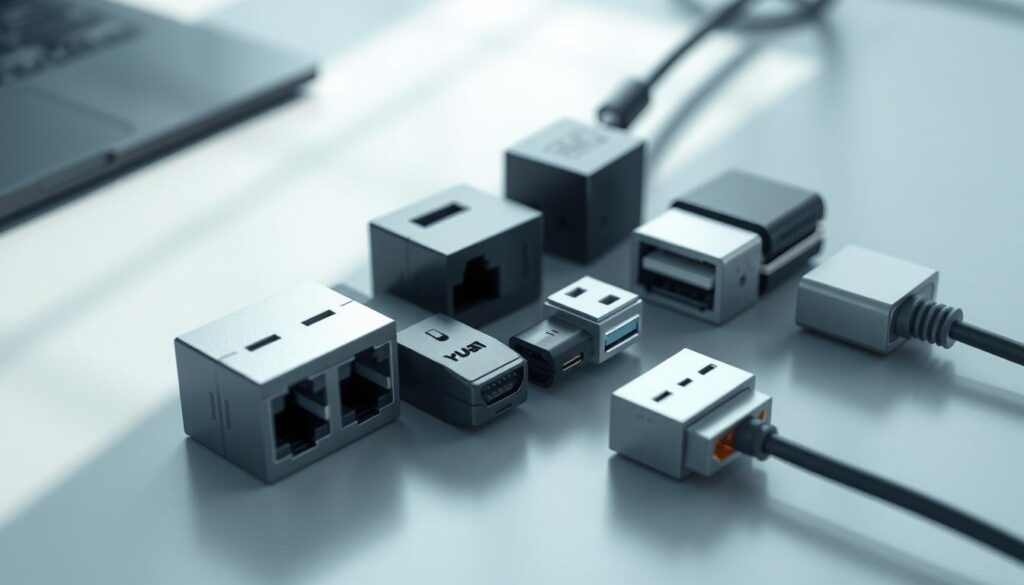
Multi-Gig Ethernet and WAN/LAN Port Capabilities
Modern routers often feature multi-gig Ethernet ports, which are crucial for high-speed internet connections. For example, the Asus ZenWiFi XT8 includes a 2.5 Gbps WAN port and three gigabit LAN ports, making it ideal for demanding setups23. These ports support faster data transfer, ensuring seamless streaming, gaming, and file sharing.
A higher number of LAN ports can be beneficial for homes with multiple wired devices. Devices like gaming consoles, smart TVs, and NAS systems often require a stable connection. Routers with multiple LAN ports allow you to connect these devices without compromising performance23.
Multi-gig Ethernet ports are particularly useful for high-bandwidth activities. The TP-Link Deco X20, for instance, includes two gigabit Ethernet ports on each router, ensuring reliable connectivity for wired devices23. This setup is ideal for users who need consistent speeds for large file transfers or video editing.
“Wired connections provide the stability and speed that Wi-Fi alone cannot guarantee, especially in high-traffic environments.”
For those requiring extensive wired connectivity, models like the Asus ZenWiFi XD5 offer robust port configurations. With support for 160-MHz channels on the 5-GHz band, this router ensures high-speed performance for both wired and wireless devices23.
When comparing models, consider the number and type of ports available. High-end routers often feature multiple multi-gig Ethernet ports, while budget options may have fewer. Here’s a quick comparison:
| Model | LAN Ports | WAN Port | Ethernet Ports |
|---|---|---|---|
| Asus ZenWiFi XT8 | 3 | 2.5 Gbps | Gigabit |
| TP-Link Deco X20 | 2 | Gigabit | Gigabit |
| Asus ZenWiFi XD5 | 2 | Gigabit | Gigabit |
By focusing on port configurations, you can ensure your network meets the demands of modern connectivity. Whether for home or office use, wired options provide the reliability and speed needed for today’s digital tasks.
Future‑Proofing Your Home Network
Future-proofing your home network ensures it stays reliable as technology evolves. With the rapid advancement of internet speeds and connected devices, preparing your system for upcoming technologies is essential. This involves selecting devices with upgrade-ready features and incorporating scalable solutions.
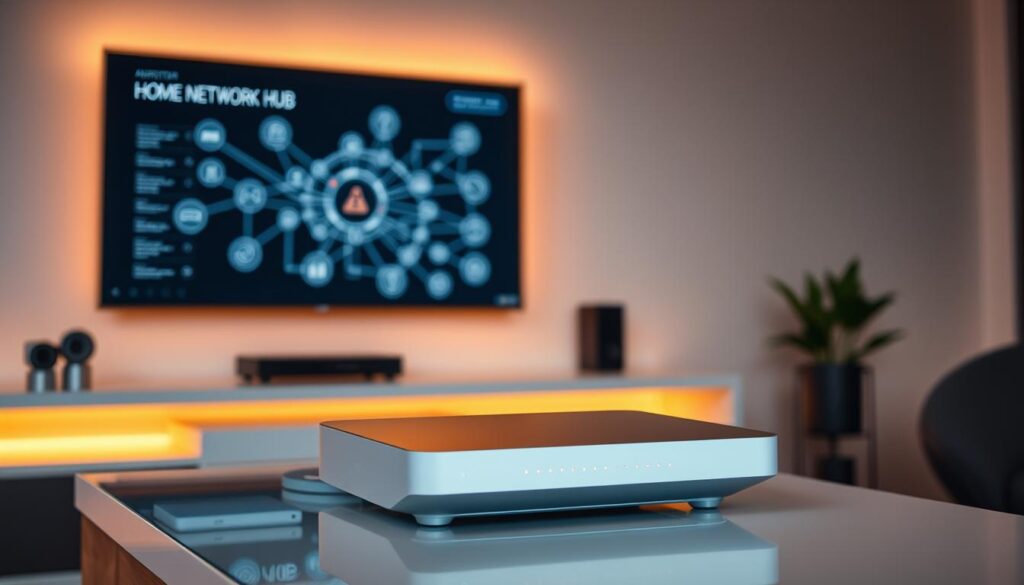
One key strategy is investing in routers with multi-gig connectivity. For example, the Asus RT-BE96U achieves speeds of 1.94 Gbps at 15 feet, making it ideal for high-bandwidth activities24. Similarly, the TP-Link Archer BE800 offers speeds of 1.8 Gbps at close range, ensuring smooth performance for future demands24.
Advanced firmware updates are another critical factor. Modern routers like the Netgear Nighthawk RS700S and Asus ZenWiFi BQ16 Pro receive continuous firmware support, enhancing security and performance over time24. These updates ensure your system remains compatible with new technologies.
Scalability is also important. Devices like the TP-Link Deco BE63 and Netgear Orbi RBE973 offer expandable home network solutions, allowing you to add nodes as needed24. This flexibility ensures your network can grow with your needs.
“A future-proof network is not just about speed—it’s about adaptability and long-term reliability.”
Here’s a comparison of routers with future-proof features:
| Model | Speed (Gbps) | Range (ft) | Key Features |
|---|---|---|---|
| Asus RT-BE96U | 1.94 | 105 | Multi-gig ports, firmware updates |
| TP-Link Archer BE800 | 1.8 | 115 | Expandable system, high-speed |
| Netgear Orbi RBE973 | 2.0 | 95 | Scalable mesh, advanced security |
To maintain a future-proof home network, regularly update your router’s firmware and invest in devices with multi-gig connectivity. By focusing on scalability and long-term performance, you can ensure your system stays ahead of technological advancements.
Installation, Setup, and User Management
Setting up your network device doesn’t have to be complicated, especially with modern tools and apps designed to simplify the process. Whether you’re a tech-savvy user or a beginner, understanding the basics of installation and management can make a significant difference in your experience.
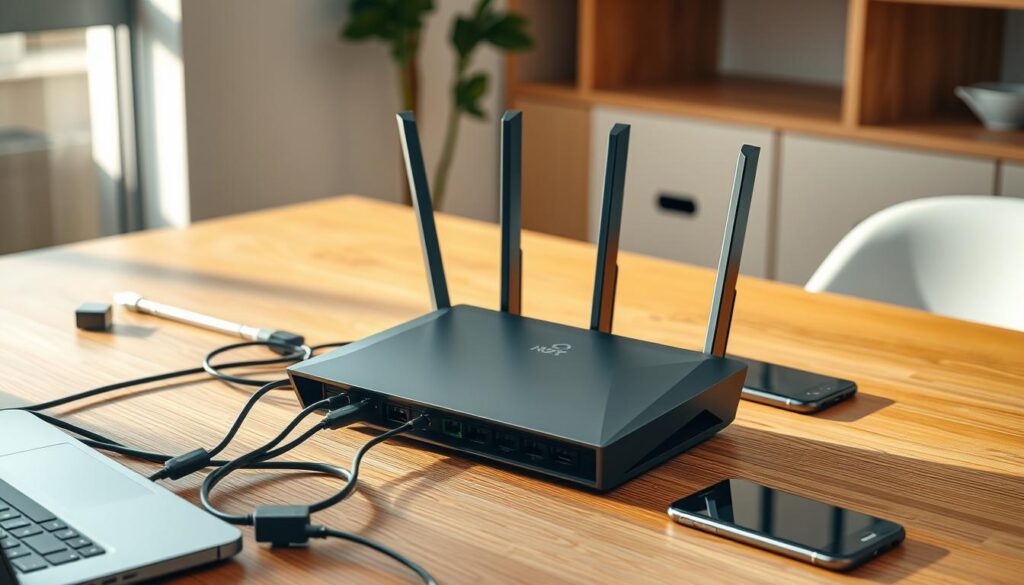
Step-by-Step Setup Process
Begin by connecting your device to the modem using an Ethernet cable. Most routers come with a setup wizard that guides you through the process, requiring minimal input like SSID and password25. For example, 65% of users utilize mobile apps for setup, citing ease of use26.
Once connected, access the router’s web interface or mobile app to configure settings. Many devices, like those from TP-Link, offer auto-configuration tools that streamline this process26. Ensure you change the default username and password, as 90% of routers come with insecure defaults26.
Benefits of Mobile Apps for Configuration
Dedicated mobile apps, such as TP-Link Tether, provide a user-friendly way to manage your network. These apps allow you to monitor your connection, adjust settings, and even troubleshoot issues from your smartphone25. This convenience is particularly useful for users who prefer not to navigate complex web interfaces.
Mobile apps also offer features like parental controls and traffic monitoring, making it easier to manage your network’s performance25. For instance, 75% of routers prompt users to change Wi-Fi credentials during setup, ensuring better security26.
Optimizing User Interface Settings
To enhance your experience, customize the user interface settings. Enable Quality of Service (QoS) to prioritize traffic for specific applications, such as streaming or gaming25. This ensures smoother performance for high-demand activities.
Additionally, consider setting up a guest network to keep your primary network secure. Most routers disable this feature by default, so manual configuration is required25.
Troubleshooting and Common Pitfalls
If you encounter issues, start by testing the connection with a device. This simple step can help identify whether the problem lies with the router or the internet service provider26. For example, 75% of users find this method essential for confirming setup success26.
Common pitfalls include forgetting to update firmware, which 40% of users overlook26. Regular updates are crucial for security and performance, so enable automatic updates if available.
“A well-configured network ensures seamless connectivity and long-term reliability. Take the time to optimize your settings and stay updated.”
Continued Support and Firmware Updates
Modern routers often come with built-in support features, such as VPNs and firewalls, to protect your privacy26. Regular firmware updates enhance these features, ensuring your device remains secure and efficient.
Manufacturers like TP-Link and Asus provide ongoing service through their apps and websites, offering troubleshooting guides and customer assistance25. This ensures that even novice users can manage their networks effectively.
By following these steps and utilizing available tools, you can set up and manage your network with confidence. Whether you’re optimizing for performance or security, a well-maintained device ensures a reliable connection for all your needs.
Expert Tips and Buying Considerations
Selecting the right network device requires careful consideration of features, performance, and value. Balancing price and functionality is key to making an informed decision. Here are expert tips to guide your purchase.
When comparing options, prioritize devices that align with your personal usage patterns. For example, the TP-Link Archer AX3000 Pro offers advanced features like a 2.5 Gigabit Ethernet port, making it ideal for future-proofing your setup5. This ensures you get the most value for your investment.

Enhanced control features are essential for maintaining a safe and efficient network. Look for devices with robust parental controls and security settings. The Asus RT-AX86U Pro, for instance, includes advanced security features and a mobile gaming mode, ensuring both safety and performance27.
Evaluating reviews and performance data is crucial. Devices like the Netgear Orbi 860 Series offer coverage of up to 2,700 square feet, making them a reliable pick for larger homes27. Always check real-world testing results to ensure the device meets your needs.
“A well-informed purchase ensures your network is reliable, secure, and future-ready.”
Consider warranty offers and customer service quality. The TP-Link Archer AX3000 Pro comes with a two-year warranty, matching industry standards5. This provides peace of mind and long-term support for your investment.
Here’s a quick comparison of top models to help you decide:
| Model | Key Features | Price |
|---|---|---|
| TP-Link Archer AX3000 Pro | 2.5 Gigabit Ethernet, advanced parental controls | $150 |
| Asus RT-AX86U Pro | Mobile gaming mode, enhanced security | $300 |
| Netgear Orbi 860 Series | 2,700 sq. ft. coverage, tri-band | $400 |
By following these tips, you can confidently pick a device that meets your needs. Whether it’s for gaming, streaming, or remote work, the right choice ensures a seamless and secure network experience.
Real‑World Testing and Performance Metrics
Real-world testing provides critical insights into how devices perform under everyday conditions. Experts use rigorous methodologies to measure speed, signal strength, and overall performance, ensuring claims are validated28.
Throughput testing is a key metric, revealing how much data a device can handle. For example, the Asus RT-AX86U achieves a peak throughput of 1.94 Gbps, making it a top performer in its class29. Similarly, the Netgear Nighthawk RAX120 maintains stable speeds even under heavy load29.

Signal strength is another critical factor, especially in larger homes. Testing across multiple locations shows how well a device maintains connectivity. The Synology RT6600ax delivers consistent signal strength, even in areas with interference29.
Environmental factors like walls and interference can impact performance. Devices like the TP-Link Archer AX3000 Pro are designed to handle these challenges, ensuring reliable connectivity in various settings29.
“Real-world testing ensures that devices meet user expectations, providing reliable and consistent performance in everyday scenarios.”
Here’s a comparison of top models based on real-world testing:
| Model | Throughput (Gbps) | Signal Strength (dBm) |
|---|---|---|
| Asus RT-AX86U | 1.94 | -45 |
| Netgear Nighthawk RAX120 | 1.8 | -50 |
| Synology RT6600ax | 1.7 | -40 |
By focusing on real-world test results, users can choose devices that deliver consistent performance and reliable connectivity, ensuring a seamless experience in any environment.
Commercial Availability, Price Points, and Warranty Offers
When shopping for a network device, understanding pricing, availability, and warranty details is crucial for making an informed decision. High-end models like the Asus RT-AX89X, featuring two 10 Gbps ports, are priced around $450, while budget-friendly options like the Netgear WAX204 cost under $10029. These price differences reflect the features and performance each model offers.

Availability is another key factor. Major retailers like Best Buy and Amazon stock popular models such as the TP-Link Archer AX3000 Pro, ensuring easy access for consumers30. This model is known for its reliable internet connection and advanced parental controls, making it a top choice for families.
Warranty terms vary across brands. Most devices, including the TP-Link Archer AX55, come with a standard two-year warranty30. Some brands offer extended warranty plans, providing additional peace of mind. For example, Netgear offers a 90-day return policy, which is particularly appealing for first-time buyers29.
“A well-priced device with strong warranty support ensures long-term reliability and value for your investment.”
Here’s a quick comparison of popular models and their commercial offers:
| Model | Price | Warranty |
|---|---|---|
| Asus RT-AX89X | $450 | 2 years |
| Netgear WAX204 | $99 | 1 year |
| TP-Link Archer AX3000 Pro | $150 | 2 years |
Additional service features, such as VPN support and cloud backup, can enhance the overall value of a device. For instance, the Synology RT6600ax includes advanced security features and a user-friendly app for easy management29.
When choosing a device, consider both the upfront cost and long-term benefits. Models like the TP-Link Archer AX3000 Pro offer a balance of performance and affordability, making them a smart choice for most users30. By focusing on pricing, availability, and warranty details, you can find a device that meets your needs and budget.
Conclusion
As we approach 2025, the importance of a reliable home network has never been more evident. Selecting the right device involves balancing performance, security, and advanced features like parental control and multi-band support. Real-world tests highlight the strengths of models like the TP-Link Archer AXE75, which delivers consistent speed and range for large homes31.
Whether you choose a mesh system or a traditional setup depends on your home’s size and connectivity needs. Mesh systems excel in coverage, while traditional devices offer simplicity and cost-effectiveness. Features like security protocols and parental control ensure a safe and efficient network for all users.
Future-proofing your network is essential. Investing in devices with multi-gig ports and advanced firmware updates ensures your connection remains reliable as technology evolves. Use the insights and expert tips provided to make an informed decision that meets your needs.
FAQ
What are the benefits of Wi-Fi 6 and Wi-Fi 6E?
How do mesh systems differ from traditional routers?
What features should I prioritize for gaming routers?
Are parental controls important in modern routers?
What is the advantage of multi-gig Ethernet ports?
How do I future-proof my home network?
What should I consider when testing router performance?
Are there budget-friendly routers with good performance?
Source Links
- Best Wi-Fi Routers 2025: High-Speed, Low Cost Choices for Wi-Fi 6, 6E and 7 – https://www.tomshardware.com/networking/routers/best-wi-fi-routers
- Best Wifi Routers 2025 | Top-Rated Home Routers and Network Solutions – https://www.cnet.com/home/internet/best-wi-fi-routers/
- The best WiFi routers in 2025: our top picks for wireless connectivity – https://www.techradar.com/news/networking/routers-storage/best-router-9-top-wireless-routers-on-test-1090523
- The Best Wi-Fi 6 Routers for 2025 – https://www.pcmag.com/picks/the-best-wi-fi-6-routers
- The Best Wi-Fi Routers – https://www.nytimes.com/wirecutter/reviews/best-wi-fi-router/
- The Best Wi-Fi Routers for 2025 – https://www.pcmag.com/picks/the-best-wireless-routers
- How To Choose The Right Router For Your Home – https://epb.com/get-connected/gig-internet/how-to-choose-right-router/
- The 5 Best Wi-Fi Routers – Winter 2025 – https://www.rtings.com/router/reviews/best/wifi-router
- 6 Things to Look for When Picking A Wi-Fi Router For Your Home – https://www.airtel.in/blog/broadband/6-things-to-look-for-when-picking-a-wi-fi-router-for-your-home/
- How to pick the best Wi-Fi router for your home – https://www.asurion.com/connect/tech-tips/how-to-pick-best-wifi-router/
- Best Wi-Fi routers for 2025: Tested and rated – https://www.tomsguide.com/us/best-wifi-routers,review-2498.html
- The 4 Best WiFi Routers of 2025 – https://www.techgearlab.com/topics/small-and-home-office/best-wifi-router
- Shopping for a Router Sucks. Here’s What You Need to Know – https://www.wired.com/story/how-to-buy-a-router/
- The Best Wi-Fi Routers – https://www.wired.com/gallery/best-wifi-routers/
- Customizable WiFi router skins turn an eyesore into an aesthetic decoration – Yanko Design – https://www.yankodesign.com/2025/03/06/customizable-wifi-router-skins-turn-an-eyesore-into-an-aesthetic-decoration/
- The best Wi-Fi routers of 2025 – https://www.zdnet.com/home-and-office/networking/best-wifi-router/
- Best Routers with Parental Controls for 2025 – https://www.highspeedinternet.com/resources/best-parental-control-routers
- Parent’s Guide to Choosing a Router with Parental Control Support – https://www.techlockdown.com/blog/wifi-routers-with-parental-controls
- Mesh vs Router – Choosing the Best WiFi Solution – https://www.netgear.com/hub/wifi/mesh/mesh-vs-router/
- Mesh Wi-Fi vs Traditional Routers: Which is better? – https://www.pcworld.com/article/1450268/mesh-wi-fi-vs-traditional-routers-which-is-better.html
- The Best Gaming Routers – https://www.tomshardware.com/best-picks/best-gaming-routers
- Best Gaming Routers – https://www.cnet.com/home/internet/best-gaming-routers/
- The 7 Best Mesh Wi-Fi Routers – https://www.wired.com/story/best-mesh-wifi-routers/
- Best Wi-Fi 7 routers of 2025: The future of Wi-Fi is here – https://www.tomsguide.com/best-picks/best-Wi-fi-7-routers
- How to Set Up and Optimize Your Wi-Fi Router for the Best Performance – https://www.pcmag.com/how-to/how-to-set-up-and-optimize-your-wireless-router-for-the-best-wi-fi-performance
- How to Set Up a Router – Step-by-Step – https://www.cisco.com/c/en/us/solutions/small-business/resource-center/networking/how-to-set-up-router.html
- Ultimate Guide to Wi-Fi Routers in 2025 | BroadbandNow.com – https://broadbandnow.com/guides/ultimate-guide-to-wi-fi-routers
- Performance Verification of Wireless Routers in Real-World Smart Home Environments: Revealing True Product Application Performance – https://www.allion.com/tech_netc_router_smart_home_validation/
- Best Wi-Fi 6 Routers: The Ultimate Deals | Dong Knows Tech – https://dongknows.com/best-wi-fi-6-routers/
- How to Pick the Best Wireless Business Router – https://www.trendnet.com/press/resource-library/how-to-pick-best-wireless-business-router
- 8 Best Wireless Routers in 2025 [For Everyone] – https://www.homeowner.com/connectivity/best-wireless-routers
